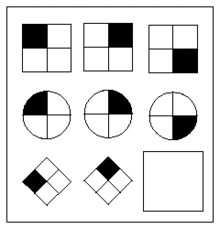Raven's Progressive Matrices

Raven's Progressive Matrices (often referred to simply as Raven's Matrices) are multiple choice tests of abstract reasoning, originally developed by Dr John C. Raven in 1936.[1] In each test item, a candidate is asked to identify the missing segment required to complete a larger pattern. Many items are presented in the form of a 3x3 or 2x2 matrix, giving the test its name.
Versions
The matrices are offered in three different forms for participants of different ability:
- Standard Progressive Matrices: These were the original form of the matrices, first published in 1938. The booklet comprises five sets (A to E) of 12 items each (e.g. A1 through to A12), with items within a set becoming increasingly difficult, requiring ever greater cognitive capacity to encode and analyze information. All items are presented in black ink on a white background.
- Colored Progressive Matrices: Designed for younger children, the elderly, and people with moderate or severe learning difficulties, this test contains sets A and B from the standard matrices, with a further set of 12 items inserted between the two, as set Ab. Most items are presented on a colored background to make the test visually stimulating for participants. However the very last few items in set B are presented as black-on-white — in this way, if participants exceed the tester's expectations, transition to sets C, D, and E of the standard matrices is eased.
- Advanced Progressive Matrices: The advanced form of the matrices contains 48 items, presented as one set of 12 (set I), and another of 36 (set II). Items are again presented in black ink on a white background, and become increasingly difficult as progress is made through each set. These items are appropriate for adults and adolescents of above average intelligence.
In addition, so-called 'parallel' forms of the standard and coloured progressive matrices were published in 1998. This was to address the problem of the Raven's Matrices being too well-known in the general population. The fact that testees have grown increasingly experienced with the Ravens over the last 60 years could explain the increases in scores of around 10 IQ points per generation (see Flynn effect). Items in the parallel tests have been constructed such that average solution rates to each question are identical for the classic and parallel versions. An extended form of the standard progressive matrices, Standard Progressive Matrices Plus, was published at the same time, offering greater discrimination among more able young adults.
The Triple Nine Society uses the Advanced Progressive Matrices form for one of their admission tests. They require a score of at least 32 out of 36 on or before December 31st, 1999 on the RAPM. The International Society for Philosophical Enquiry (ISPE) similarly accepts the RAPM as a qualification for admission.
Underlying factors
According to their author, Raven's Progressive Matrices and Vocabulary tests measure the two main components of general intelligence (originally identified by Spearman): the ability to think clearly and make sense of complexity, which is known as eductive ability (from the Latin root "educere", meaning "to draw out") and the ability to store and reproduce information, known as reproductive ability.

A 2007 study provided evidence that individuals with Asperger syndrome, a high-functioning autism spectrum disorder, score higher than individuals without Asperger syndrome on Raven's tests.[2] A separate 2007 study provided evidence that individuals with classic autism, a low-functioning autism spectrum disorder, score higher in Raven's tests than in Wechsler tests. In addition the individuals with classic autism were providing correct answers to the Raven's test in less time than individuals without autism, although erring as often.[3]
John Carlyle Raven first published his Progressive Matrices in the United Kingdom in 1938. His three sons established Scotland-based test publisher J C Raven Ltd. in 1972. In 2004, Harcourt Assessment, Inc. a division of Harcourt Education acquired J C Raven Ltd.
Notes
- ^ Raven, J. C. (1936). Mental tests used in genetic studies: The performance of related individuals on tests mainly educative and mainly reproductive. MSc Thesis, University of London.
- ^ Hayashi et al. (2007) http://www.freewebs.com/adiscussion/Superior%20fluid%20intelligence%20in%20children%20with%20Asperger's%20disorder.pdf
- ^ Dawson M, Soulières I, Gernsbacher MA, Mottron L (2007). "The level and nature of autistic intelligence". Psychol Sci. 18 (8): 657–62. doi:10.1111/j.1467-9280.2007.01954.x. PMID 17680932.
{{cite journal}}: Unknown parameter|laydate=ignored (help); Unknown parameter|laysource=ignored (help); Unknown parameter|laysummary=ignored (help)CS1 maint: multiple names: authors list (link)
References
- Raven, J., Raven, J.C., & Court, J.H. (2003). Manual for Raven's Progressive Matrices and Vocabulary Scales. Section 1: General Overview. San Antonio, TX: Harcourt Assessment.
